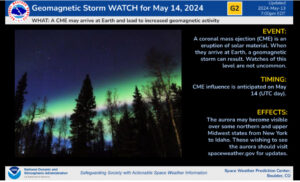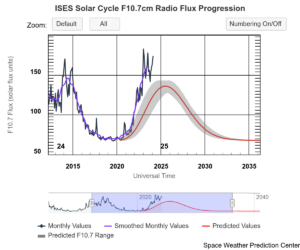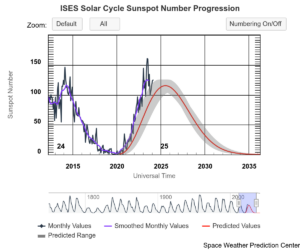
Space Weather
Latest Headlines
05.14.2024 10:37Z (NOAA Space Weather Prediction Center)

05.14.2024 10:29z (Australian Space Weather Forecasting Center)
Solar activity on UT day 14-May is expected to be at R1-R2 levels, with a chance of R3. The solar wind speed is expected to be strong, with an overall declining trend. G0 geomagnetic conditions are expected, with a chance of G1. S1 solar radiation conditions are expected. HF radio communication conditions are now expected to be mostly normal, with degradations at high latitudes. Maximum usable frequencies are expected to be near predicted monthly values to 15% enhanced. Shortwave fadeouts are expected.
Older Headlines
05.12.2024 23:38Z (Australian Space Weather Forecasting Center)
Solar activity on UT day 13-May is expected to be at R2-R3 levels. The large and complex solar region that has recently produced R3 solar flare and CME activity is nearing the south west solar limb. A weak solar wind shock was observed at 12/0856UT. The solar wind speed is expected to be strong, with an overall declining trend. Planetary G3 and Australian region G2 conditions were observed early in the UT on 12-May as geomagnetic storm activity on 11-May declined. The anticipated further geomagnetic storm activity on 12-May did not eventuate. G1, chance G2 geomagnetic storm conditions are expected on 13-May. No solar radiation storm is in progress. HF radio communication conditions are now expected to be mostly normal for today. Maximum usable frequencies are expected to be near predicted monthly values to 15% enhanced. Frequent shortwave fadeouts are expected.
05.12.2024 (Spaceweather.com)
THE STORM IS OVER, BUT… This weekend’s extreme geomagnetic storm is over, but there might be a last gasp. NOAA forecasters are currently predicting a return to severe (G4) conditions on May 12th when one or more CMEs might hit Earth’s magnetic field. Of particular interest is the CME from yesterday’s X5.8-class flare — a potent storm cloud that could spark renewed auroras if its internal magnetic field is oriented correctly.
Space Weather Down Under….
From the Australian Bureau of Meteorology, here’s a site featuring ionospheric maps, maps showing tropospheric conditions (in our lower atmosphere) in the Australian / Asian area of the world. Frequently, what happens there, happens in the America’s shortly after. There’s a lot more information there, however, than just maps! Check it out… CLICK HERE.
The following data is provided from NOAA



